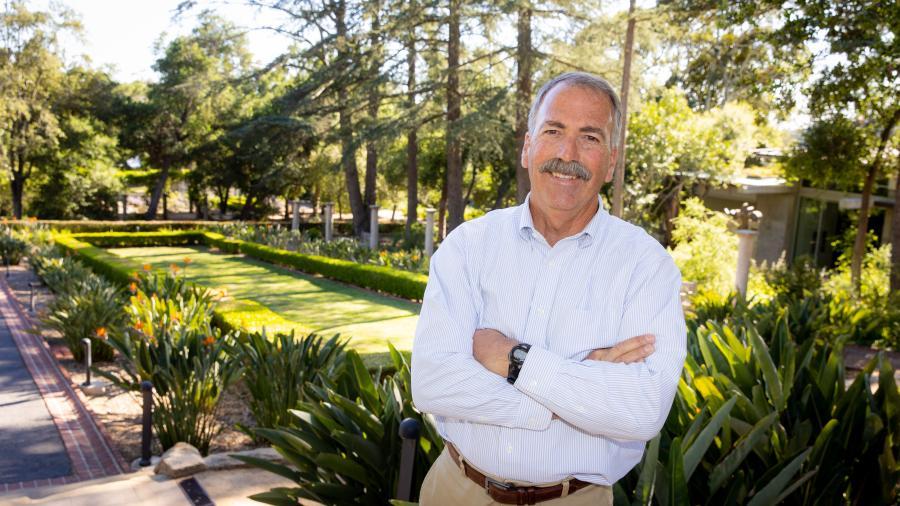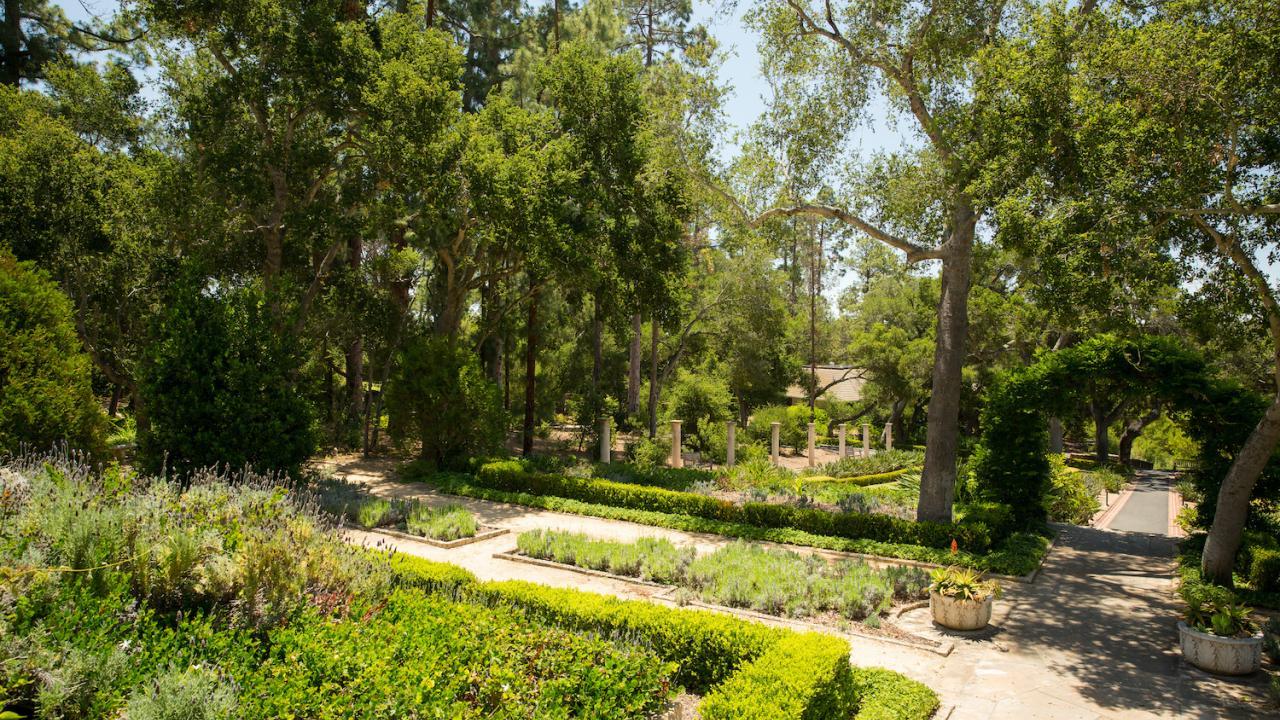Westmont Magazine The Man Behind the Plan

When Randy Jones, director of campus planning, retired March 31, he left a campus vastly different than the one he first surveyed in 1995. During a 27-year career at Westmont, he has overseen the addition of major new facilities on campus, the recovery from the 2008 Tea Fire and the renovation of many buildings and much of the landscaping.
Randy jokes that he came to Westmont as the inexpensive version of Carl Johnson, a nationally known architect and planner from Michigan. Johnson had worked with Randy on a project at Mount Hermon, another Christian organization in California with a beautiful campus. When Westmont officials began discussing the development of a campus master plan, they contacted Johnson, and he suggested they contract with Randy. As a consultant working closely with Johnson, Randy developed a preliminary master plan and presented it to the president’s staff. Ron Cronk, then vice president for finance, asked how they could implement it. “Hire Randy,” Johnson said. “He’s been doing the same thing at Mount Hermon.” After 11 years at the Christian conference center and a previous position as an architect, Randy joined the Westmont staff.
“Westmont presented an interesting opportunity,” Randy says. His work began with Las Barrancas and the first phase of affordable homes for Westmont professors. Then he tackled the master plan, collecting information from people on campus about their need for space and devising a list of necessary new buildings. With advice from Johnson and feedback from the Westmont community, Randy completed the first draft of the master plan and submitted it to local officials. That action kicked off a seven-year process of obtaining approval for the document, which outlined new facilities the college intended to build.
Hundreds of meetings with neighbors and numerous public hearings ensued and led to major changes to the architecture of new buildings. Moving away from the Spanish Mediterranean style typical in Santa Barbara, the college decided against tile roofs in keeping with Kerrwood Hall and its slate roof. “We developed buildings more re- sponsive to the natural environment like Winter Hall and Adams Center,” Randy says. Setting both structures into the hillside limited their height, and plants on the roof helped them blend in with the surrounding landscape, reflecting the character of Westmont’s garden campus.
Gaining approval for the plan in 2007, the college broke ground in 2008 for Winter Hall for Science and Mathematics and Adams Center for the Visual Arts, which includes the Westmont Ridley-Tree Museum of Art.
Two weeks after the groundbreaking ceremonies, the Tea Fire tore through campus, destroying eight buildings (including three slated for demolition) and about a third of the vegetation on campus. “The Tea Fire slowed us down for just a few days,” Randy says. “But we made up that time. All the guys working on the new buildings came to campus and helped us recover. They became longtime friends and an important part of our team.
“The fire helped us improve the riparian areas by removing non-native vegetation, saving us a lot of money. We planted back native plants as we restored these areas.”
Winter Hall and Adams Center both received high ratings for their environmental sustainability, a goal Randy has pursued in all new construction. This first phase also included the Westmont Observatory, Thorrington Field and the Westmont Track, the renovated Carr Field, the rerouted road and the central plant. Subsequently, the college constructed the Global Leadership Center, which features two large residential buildings as well as the central conference facility. “We fit these buildings in among the existing oak trees, adapting it to the topography,” Randy says.
Ten structures still need to be built. Before he left, Before he left, Westmont received the permit for the engineering building, and construction began in April. “The bottom floor will house the engineering program with space for projects,” he says. “The upstairs will provide storage for a variety of departments. We’ll finally have room to keep things rather than discarding them because of a lack of space.”
Two to three years after completing the engineering building, Westmont will be eligible to add another facility. “It will take at least that long to decide on the structure and develop plans for it,” Randy says.
While he has helped add essential new buildings to campus, Randy especially values his work on the grounds. “Clearing out the jungle on Kerrwood Circle and turning a solid mass of green into a beautiful garden was satisfying,” he says. “The Louise Lowry Davis Garden beautifully restored the first two terraces of the formal gardens below Kerrwood Hall. We cut back overgrowth and opened up the campus so you can see where you’re going. We cleared out the barrancas so the grounds can breathe. Those changes made a big difference early on and built trust with people at Westmont.” Randy and his wife, Bridget, plan to stay in the local area and spend more time with their two daughters, Shelby ’09 and Courtney ’11, and their families, including their three grandchildren.
RANDY’S PROJECT LIST 1995–2022
-
Las Barrancas homes for faculty
-
Campus gardens restoration
-
Campus road relocation
-
Adams Center for the Visual Arts
-
Winter Hall for Science and Mathematics
-
Observatory
-
Central Plant
-
Carr Field
-
Steel bridge to the Global Leadership Center
-
Track and Thorrington Field and the Track Building
-
Riparian enhancement and restoration of the barrancas
-
Las Barrancas Tea Fire rebuild
-
Clark F, M, S, T Tea Fire rebuilds
-
Temporary classrooms and labs following the Tea Fire
-
Dining Commons renovation
-
Porter Hall Renovation
-
Hubbard Hall renovation
-
Music Building
-
Kerrwood offices
-
Kerrwood modular structures
-
915 La Paz remodel
-
Tejado Grove homes for Westmont employees
-
Parking lots, new and renovated
-
Campus lighting
-
Campus furniture, tables, chairs and trash receptacles
-
Golf Practice Facility
-
Entry Kiosks
-
26 West Anapamu third floor
-
26 West Anapamu first and second floors for nursing
-
Engineering/Warehouse Building (under construction)
-
Renovations of faculty and staff offices
-
Renovation of residence hall spaces
-
President’s house renovations and addition
-
Voskuyl Chapel renovation
-
Murchison Gymnasium renovation
-
Training Room renovation
-
Fitness Center addition
-
Earthquake and other renovations for Westmont in San Francisco
-
Global Leadership Center
-
Van Kampen Hall renovations
-
Stone wall and landscape north of the campus store
-
Physical Plant rebuild after the fire











